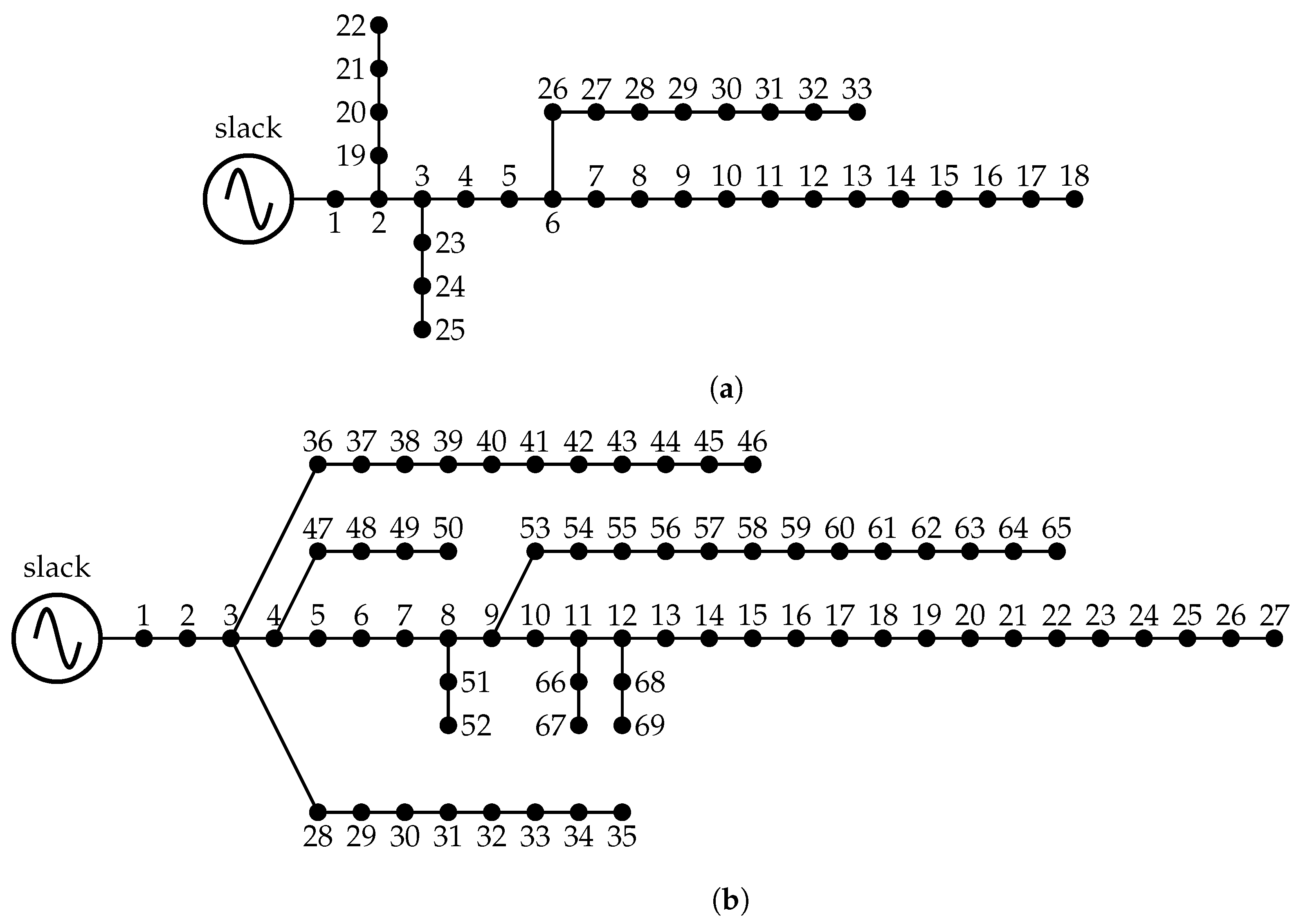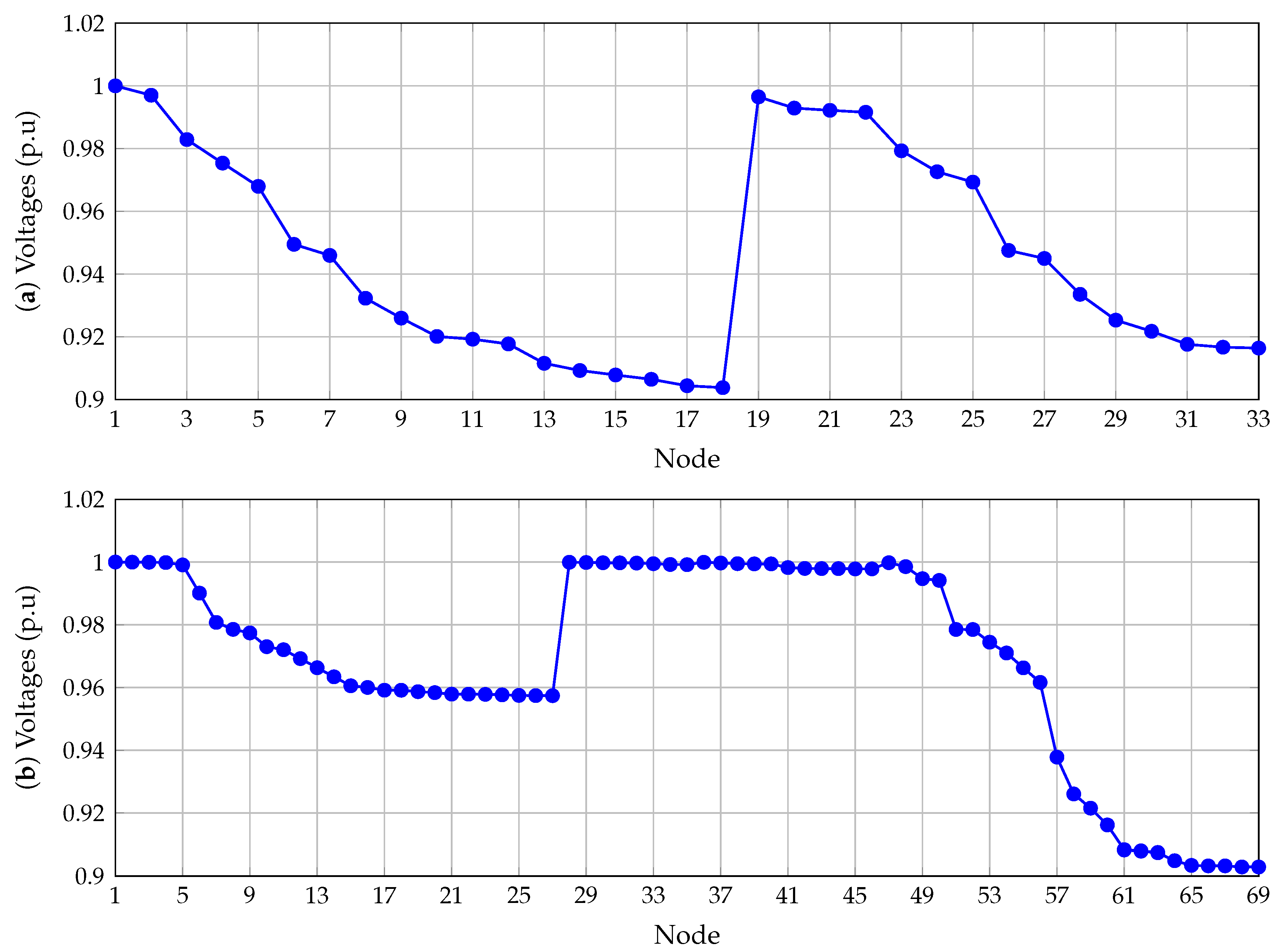The Equivalence between Successive Approximations and Matricial Load Flow Formulations
Abstract
1. Introduction
2. SA Load Flow
3. MBF Load Flow
- when branch i connects bus j and its current is leaving bus i;
- when branch i connects bus j and its current is arriving bus j;
- when branch i has no connection with bus j.
4. Demonstration of the Equivalence
5. Test Systems and Comparative Methods
6. Numerical Validation
- √
- The conventional GS approach exhibits the worst performance in terms of processing times and the number of iterations required to solve the load flow problem in both test feeders. In addition, the accelerated version of the GS approach allows for improvement in its performance (i.e., the GS behavior) by reducing processing times by about % and for the 33- and 69-bus distribution grids, while the number of iterations is reduced by about and respectively;
- √
- The classical NR and LM load flow approaches have the same numerical performance regarding the total iterations required to solve the load flow problem in both test feeders with 5 iterations in both cases. The low number of iterations in these methods is attributed to the fact that both work with the Jacobian matrix, which contains information about the direction of the maximum change of load flow equations, a situation that does not occur for the remainder of the load flow methods, as these do not use information of the derivatives of the load flow equations. With regard to processing times, the NR and LM methods are very similar, as in the case of the system with 33 buses, the difference is lower than ms, and in the case of the system composed of 69 buses, this difference is about ms;
- √
- The numerical results for the 33- and 69-node test feeders obtained for the SA and the MBF load flow methods, i.e., the equivalent load flow approaches, is the same regarding the number of iterations, as these take 10 iterations to solve the load flow problem in both test feeders however, regarding the processing times, we can observe that the SA is the faster approach as demonstrated in [12]. Even if both methods are equivalent, the SA approach calculates the admittance matrix, i.e., , using the direct method by adding the inverse of the conductance at this line, while the MBF method uses matricial calculations for the products between the incidence matrix and the primitive matrices, which consumes additional processing times.
7. Conclusions
Author Contributions
Funding
Institutional Review Board Statement
Informed Consent Statement
Data Availability Statement
Acknowledgments
Conflicts of Interest
References
- Abdi, H.; Beigvand, S.D.; Scala, M.L. A review of optimal power flow studies applied to smart grids and microgrids. Renew. Sustain. Energy Rev. 2017, 71, 742–766. [Google Scholar] [CrossRef]
- Lavaei, J.; Low, S.H. Zero Duality Gap in Optimal Power Flow Problem. IEEE Trans. Power Syst. 2012, 27, 92–107. [Google Scholar] [CrossRef]
- Marini, A.; Mortazavi, S.; Piegari, L.; Ghazizadeh, M.S. An efficient graph-based power flow algorithm for electrical distribution systems with a comprehensive modeling of distributed generations. Electr. Power Syst. Res. 2019, 170, 229–243. [Google Scholar] [CrossRef]
- Phongtrakul, T.; Kongjeen, Y.; Bhumkittipich, K. Analysis of Power Load Flow for Power Distribution System based on PyPSA Toolbox. In Proceedings of the 2018 15th International Conference on Electrical Engineering/Electronics, Computer, Telecommunications and Information Technology (ECTI-CON), Chiang Rai, Thailand, 18–21 July 2018. [Google Scholar] [CrossRef]
- Prabhu, J.A.X.; Sharma, S.; Nataraj, M.; Tripathi, D.P. Design of electrical system based on load flow analysis using ETAP for IEC projects. In Proceedings of the 2016 IEEE 6th International Conference on Power Systems (ICPS), New Delhi, India, 4–6 March 2016. [Google Scholar] [CrossRef]
- Grainger, J.J.; Stevenson, W.D. Power System Analysis; McGraw-Hill series in electrical and computer engineering: Power and energy; McGraw-Hill: New York, NY, USA, 2003. [Google Scholar]
- Gönen, T. Modern Power System Analysis; CRC Press: Boca Raton, FL, USA, 2016. [Google Scholar]
- Montoya, O.D.; Gil-González, W.; Giral, D.A. On the Matricial Formulation of Iterative Sweep Power Flow for Radial and Meshed Distribution Networks with Guarantee of Convergence. Appl. Sci. 2020, 10, 5802. [Google Scholar] [CrossRef]
- Shen, T.; Li, Y.; Xiang, J. A Graph-Based Power Flow Method for Balanced Distribution Systems. Energies 2018, 11, 511. [Google Scholar] [CrossRef]
- Garces, A. A Linear Three-Phase Load Flow for Power Distribution Systems. IEEE Trans. Power Syst. 2016, 31, 827–828. [Google Scholar] [CrossRef]
- Bocanegra, S.Y.; Gil-Gonzalez, W.; Montoya, O.D. A New Iterative Power Flow Method for AC Distribution Grids with Radial and Mesh Topologies. In Proceedings of the 2020 IEEE International Autumn Meeting on Power, Electronics and Computing (ROPEC), Ixtapa, Mexico, 4–6 November 2020. [Google Scholar] [CrossRef]
- Montoya, O.D.; Gil-González, W. On the numerical analysis based on successive approximations for power flow problems in AC distribution systems. Electr. Power Syst. Res. 2020, 187, 106454. [Google Scholar] [CrossRef]
- Li, Z.; Yu, J.; Wu, Q.H. Approximate Linear Power Flow Using Logarithmic Transform of Voltage Magnitudes With Reactive Power and Transmission Loss Consideration. IEEE Trans. Power Syst. 2018, 33, 4593–4603. [Google Scholar] [CrossRef]
- Montoya, O.D. On Linear Analysis of the Power Flow Equations for DC and AC Grids With CPLs. IEEE Trans. Circuits Syst. II Express Briefs 2019, 66, 2032–2036. [Google Scholar] [CrossRef]
- Molzahn, D.K.; Hiskens, I.A. Sparsity-Exploiting Moment-Based Relaxations of the Optimal Power Flow Problem. IEEE Trans. Power Syst. 2015, 30, 3168–3180. [Google Scholar] [CrossRef]
- Grisales-Noreña, L.; Montoya, D.G.; Ramos-Paja, C. Optimal Sizing and Location of Distributed Generators Based on PBIL and PSO Techniques. Energies 2018, 11, 1018. [Google Scholar] [CrossRef]
- Simpson-Porco, J.W.; Dorfler, F.; Bullo, F. On Resistive Networks of Constant-Power Devices. IEEE Trans. Circuits Syst. II Express Briefs 2015, 62, 811–815. [Google Scholar] [CrossRef]
- Montoya, O.D.; Garrido, V.M.; Gil-Gonzalez, W.; Grisales-Norena, L.F. Power Flow Analysis in DC Grids: Two Alternative Numerical Methods. IEEE Trans. Circuits Syst. II Express Briefs 2019, 66, 1865–1869. [Google Scholar] [CrossRef]
- Montoya, O.D. On the Existence of the Power Flow Solution in DC Grids With CPLs Through a Graph-Based Method. IEEE Trans. Circuits Syst. II Express Briefs 2020, 67, 1434–1438. [Google Scholar] [CrossRef]
- Kaur, S.; Kumbhar, G.; Sharma, J. A MINLP technique for optimal placement of multiple DG units in distribution systems. Int. J. Electr. Power Energy Syst. 2014, 63, 609–617. [Google Scholar] [CrossRef]
- Gil-González, W.; Montoya, O.D.; Rajagopalan, A.; Grisales-Noreña, L.F.; Hernández, J.C. Optimal Selection and Location of Fixed-Step Capacitor Banks in Distribution Networks Using a Discrete Version of the Vortex Search Algorithm. Energies 2020, 13, 4914. [Google Scholar] [CrossRef]
- Riaño, F.E.; Cruz, J.F.; Montoya, O.D.; Chamorro, H.R.; Alvarado-Barrios, L. Reduction of Losses and Operating Costs in Distribution Networks Using a Genetic Algorithm and Mathematical Optimization. Electronics 2021, 10, 419. [Google Scholar] [CrossRef]
- Montoya, O.D.; Gil-González, W.; Hernández, J.C. Efficient Operative Cost Reduction in Distribution Grids Considering the Optimal Placement and Sizing of D-STATCOMs Using a Discrete-Continuous VSA. Appl. Sci. 2021, 11, 2175. [Google Scholar] [CrossRef]
- Taher, S.A.; Karimi, M.H. Optimal reconfiguration and DG allocation in balanced and unbalanced distribution systems. Ain Shams Eng. J. 2014, 5, 735–749. [Google Scholar] [CrossRef]
- Priyadarshini, R.; Prakash, R.; Shankaralingappa, C.B. Network Reconfiguration of radial distribution network using Cuckoo Search Algorithm. In Proceedings of the 2015 Annual IEEE India Conference (INDICON), New Delhi, India, 17–20 December 2015. [Google Scholar] [CrossRef]
- Lagace, P.J.; Vuong, M.H.; Kamwa, I. Improving power flow convergence by Newton Raphson with a Levenberg-Marquardt method. In Proceedings of the 2008 IEEE Power and Energy Society General Meeting—Conversion and Delivery of Electrical Energy in the 21st Century, Pittsburgh, PA, USA, 20–24 July 2008; pp. 1–6. [Google Scholar]
- Milano, F. Analogy and Convergence of Levenberg’s and Lyapunov-Based Methods for Power Flow Analysis. IEEE Trans. Power Syst. 2016, 31, 1663–1664. [Google Scholar] [CrossRef]


| Method | Proc. Time (ms) | Iterations | Losses (p.u) |
|---|---|---|---|
| Test system composed of 33 buses | |||
| GS | 441.973960 | 2313 | 2.109785 |
| AG | 38.555403 | 227 | 2.109785 |
| NR | 10.751203 | 5 | 2.109785 |
| LM | 10.881656 | 5 | 2.109785 |
| MBF | 1.322962 | 10 | 2.109785 |
| SA | 0.518957 | 10 | 2.109785 |
| Test system composed of 69 buses | |||
| GS | 31107.756292 | 49031 | 2.421523 |
| AG | 1662.690792 | 2455 | 2.421523 |
| NR | 38.303088 | 5 | 2.421523 |
| LM | 42.719055 | 5 | 2.421523 |
| MBF | 5.369374 | 10 | 2.421523 |
| SA | 2.488095 | 10 | 2.421523 |
| Iteration | SA | MBF |
|---|---|---|
| 1 | 8.8223 | 8.8223 |
| 2 | 8.0437 | 8.0437 |
| 3 | 7.5688 | 7.5688 |
| 4 | 7.5134 | 7.5134 |
| 5 | 7.1145 | 7.1145 |
| 6 | 7.0636 | 7.0636 |
| 7 | 6.6881 | 6.6881 |
| 8 | 6.6400 | 6.6400 |
| 9 | 6.2870 | 6.2870 |
| 10 | 6.2418 | 6.2418 |
Publisher’s Note: MDPI stays neutral with regard to jurisdictional claims in published maps and institutional affiliations. |
© 2021 by the authors. Licensee MDPI, Basel, Switzerland. This article is an open access article distributed under the terms and conditions of the Creative Commons Attribution (CC BY) license (http://creativecommons.org/licenses/by/4.0/).
Share and Cite
Herrera-Briñez, M.C.; Montoya, O.D.; Alvarado-Barrios, L.; Chamorro, H.R. The Equivalence between Successive Approximations and Matricial Load Flow Formulations. Appl. Sci. 2021, 11, 2905. https://doi.org/10.3390/app11072905
Herrera-Briñez MC, Montoya OD, Alvarado-Barrios L, Chamorro HR. The Equivalence between Successive Approximations and Matricial Load Flow Formulations. Applied Sciences. 2021; 11(7):2905. https://doi.org/10.3390/app11072905
Chicago/Turabian StyleHerrera-Briñez, María Camila, Oscar Danilo Montoya, Lazaro Alvarado-Barrios, and Harold R. Chamorro. 2021. "The Equivalence between Successive Approximations and Matricial Load Flow Formulations" Applied Sciences 11, no. 7: 2905. https://doi.org/10.3390/app11072905
APA StyleHerrera-Briñez, M. C., Montoya, O. D., Alvarado-Barrios, L., & Chamorro, H. R. (2021). The Equivalence between Successive Approximations and Matricial Load Flow Formulations. Applied Sciences, 11(7), 2905. https://doi.org/10.3390/app11072905








